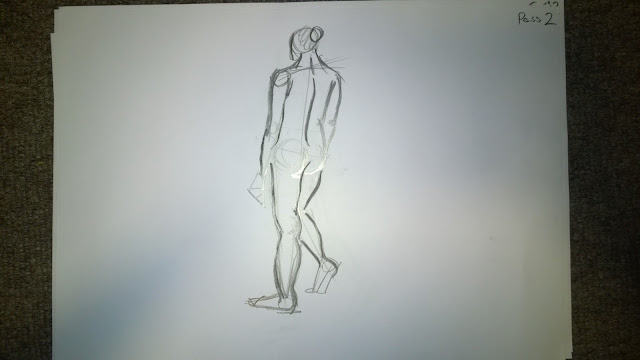Life Drawing: 26th November 2015
Introduction
Within this session we did a range of exercises that tested our drawing techniques. This included reducing the size of our drawings and how we draw the model.
Initial Poses (Warm-Up Sketches)
These are just sketches that I did at the start of the session where we had to draw the model in a few minutes. These are done just to start the session and get in the mind set of life drawing. As shown there are a number of improvements I would make in proportion and completion because most of these drawings are incorrect and incomplete. However this is only an initial piece to the session; I needed to make those mistakes for me to build from those throughout the rest of the session and get me into the life drawing mind set.
[Initial Piece- Pencil and Charcoal]
One Minute Poses
This is the second piece I created in the session where we had to draw the pose of the model within a minute. This is a very short amount of time to capture the model; therefore detail was not essential, we had to capture the full model and express the essence of the pose in that short time. As shown there is no detail and are very few lines to capture the model's form and action. I would improve these drawings by trying to capture the proportions of the model first by mapping out and quickly recording the model's pose. I would then spend the short time fixing any problems with what I captured.
[One Minute Poses- Charcoal]
Ice Rink Test
This next piece was an experimental piece where we had to close our eyes, and using a thick pencil or charcoal recreate a path of an ice-skater. This was to improve our understanding of the strength of the line and to use large and confident strokes in our lines rather than broken or 'noisy' lines. As shown my lines and path are rather broken because I focused on the rhythm of the skater as he/she would move his/her feet forward. Therefore one lunge for one foot would be a line then followed by another; then another etc.
[Ice Rink Test Piece-Charcoal]
Miniature Sketches
This next piece is of a series of miniature sketches we had to create on an A4 piece of paper and had to fit nine different sketches of the whole model. This was to challenge us to try and just focus on the core features of the model rather than the details such as the pose rather than the detail o the hair of the model. This was a challenge because I am used to drawing large sketches on A3 paper and I try to avoid detail anyway and focus on correcting the proportions. Because of the restricted space to fit other sketches on the same page, you can see that the model is 'squashed' in a number of sketches.
[Miniature Sketches - Pencil and Charcoal]
Target Piece
This piece was unique because before we drew the model, we had to observe her for a minute and assess key features of the pose and create targets that we would have to meet as we drew the model.
The targets I set myself were:
- Supported Weight - This was to try and show that the model's weight was being supported by the easel.
- Sense of Helplessness/ Weakness - I felt that was an 'aura' of helplessness and I wanted to show this in my piece.
- Dependence - I wanted to express a sense of dependence of the model and the easel through my drawing.
- Contrast of Materials (Flesh vs. Wood) - I wanted to express the contrast of the harsh wooden material of the easel and the soft flesh of the model.
As you can see the piece was not finished as we had a limited time to complete our drawings. I would improve this piece by completing it with charcoal for the body to show the contrast of wood and flesh.
[Target Piece - Pencil and Charcoal]
Animated Piece ;- Walk Cycle: 2nd Edition
These next pieces are of a collection where the model was posing in the key positions of a walk. We had to capture the model in those poses accurately; that when we compiled these drawings together they would show the model walking. Therefore creating an animated walk cycle of our model.
[Low Position 1.2]
[Passing Position 1.3]
[High Position 1.4]
[Extended Position 2.5]
[Low Position 2.6]
[Passing Position 2.7]
[High Position 2.8]
Conclusion
In conclusion I feel that this challenging session has made me think and observe my drawings and sketches more than before. I feel that I have also learnt about space and confidence in my drawings.
I will use this in future sessions to portray the model's pose clearly by using confident and strong lines.














No comments:
Post a Comment